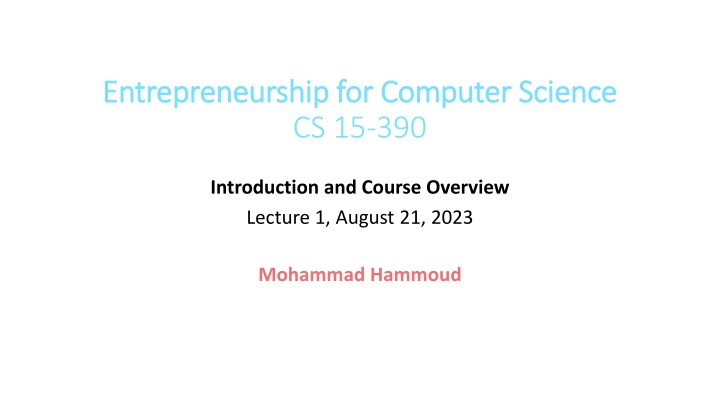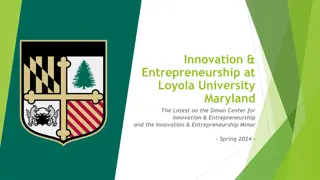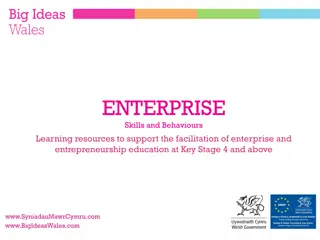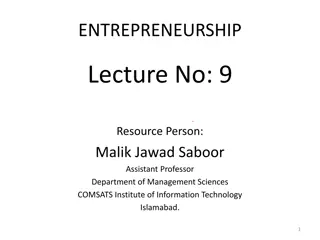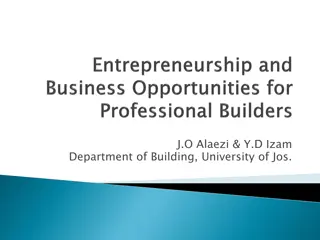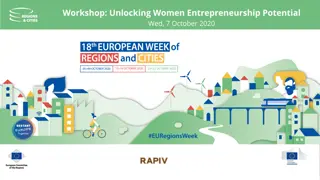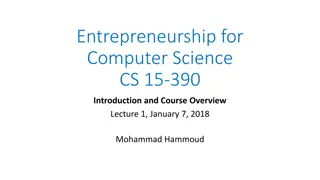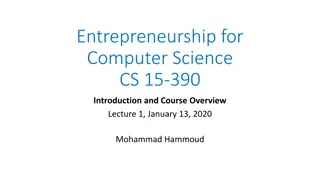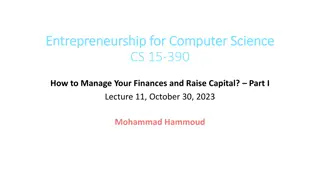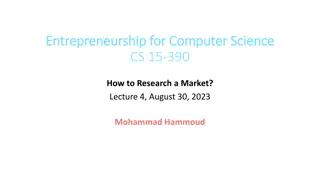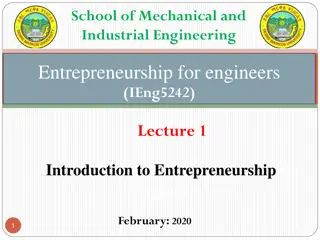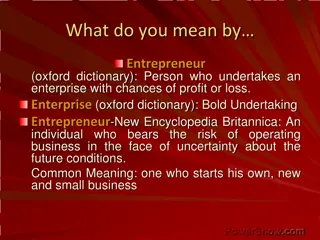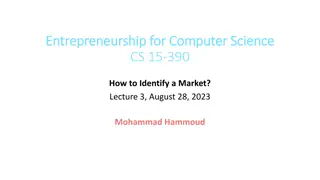Entrepreneurship for Computer Science Entrepreneurship for Computer Science
Dive into the world of entrepreneurship with a focus on the reasons behind startup failures, the hero's journey in business, the human aspect behind great stories, and the distinction between fear and real danger in pursuing entrepreneurial endeavors.
Download Presentation

Please find below an Image/Link to download the presentation.
The content on the website is provided AS IS for your information and personal use only. It may not be sold, licensed, or shared on other websites without obtaining consent from the author.If you encounter any issues during the download, it is possible that the publisher has removed the file from their server.
You are allowed to download the files provided on this website for personal or commercial use, subject to the condition that they are used lawfully. All files are the property of their respective owners.
The content on the website is provided AS IS for your information and personal use only. It may not be sold, licensed, or shared on other websites without obtaining consent from the author.
E N D
Presentation Transcript
Entrepreneurship for Computer Science Entrepreneurship for Computer Science CS 15-390 Introduction and Course Overview Lecture 1, August 21, 2023 Mohammad Hammoud
Today Introduction: Why not everyone is an entrepreneur? Entrepreneurship paradigm and principles Why most startups fail? Course overview: Objectives, structure, and learning outcomes Announcement: All course material can be found at: http://www.qatar.cmu.edu/~mhhammou/15390-f23/index.html
Outline Introduction Course Overview and Administrivia Why Most Startups Fail?
Heros Journey: Basic Ingredients Identified by the author and philosopher Joseph Campbell: Someone has a crazy idea (not a hero yet) People doubt her She leaves the village to pursue her vision She faces untold obstacles, falls into an abyss, barely escapes death But, she persists enough and manages to circumvent all the obstacles and challenges And, eventually continues to a triumphant return (now, she is a hero) These are the key elements of many great business stories as well!
Behind Every Great Story, a Human! Great businesses are created by people (like you and me!) Many of them indicated that they had sleepless nights and midnight terrors (to an extent that it became a pattern among them that you cannot miss) Most of them, at some point, even felt like imposters So, they are not natural superheroes But they possess something unique; what is it?
Entrepreneurs They took the leap That is basically it! They are called entrepreneurs They are not chosen They are self-made You can be one of them But why not everyone is one of them?
Is it Dangerous or Just Scary? We are not good at differentiating between things that terrify us (i.e., fear) and things that present real hazards (i.e., danger) We re scared of flying, but have no problem of zipping down the highway in our cars at 130 Km/Hr, even though we re 86 timesmore likely to die in a car accident than a plane crash Why is this? Brilliant writer-scholar James Fallows wrote in a 2014 article for The Atlantic: We re more relaxed around things we re more acquainted with Entrepreneurship is NOT dangerous; it is just scary
Entrepreneurship is Not Dangerous Reid Hoffman (PayPal alumnus and LinkedIn founder) said: Starting a company is like throwing yourself of the cliff and assembling an airplane on the way down When you measure the jump and carefully pack, check, and triple- check a parachute, it will not be dangerous (but still scary) This course will teach you how to measure the jump, pack & carefully check a parachute, and assemble an airplane on the way down
Entrepreneurship Paradigm A System of Functions Paradigm: Functions Identify & Research a Market Found or Co-found a Company Build a Business Model Identify a Problem Build a Prototype Bootstrap and/or Raise Angle Fund Raise Market & Operate Build a Culture Build an MVP Professional Money Scale Exit
Entrepreneurship Principles Principles Under each function of the entrepreneurship paradigm, we will study several principles that can guide you through the process We define a principle as: A fundamental truth or proposition that serves as the foundation for a system of functions These principles are applicable to different industries and startups (they have been extracted from 1000s of case studies)
Outline Introduction Course Overview and Administrivia Why Most Startups Fail?
Course Objectives Starting a new venture is a serious undertaking with a great deal of risk and sacrifice The objective of this course is to increase your odds of succeeding in starting, executing, scaling, and exiting a company The course will provide you with: A practical end-to-end paradigm to found and run a company Well-established principles that will guide you throughout the process
Entrepreneurship Paradigm A System of Functions Paradigm: Functions Identify & Research a Market Found or Co-found a Company Build a Business Model Identify a Problem Build a Prototype 1 Lecture 2 Lectures 1 Lecture 1 Lecture Bootstrap and/or Raise Angle Fund Raise Market & Operate Build a Culture Build an MVP Professional Money 1 Lecture 1 Lecture 1 Lecture 5 Lectures 1 Lecture Total = 16 Lectures Scale Exit 1 Lecture 1 Lecture
Lectures In each lecture, we will define and discuss the nuances of each function, alongside presenting 2 or 3 related principles E.g., Create buzz and engineer word of mouth under Market & Operate (The Hangover in 2009 and Barbie in 2003) Several case studies will be presented and discussed, including Apple, Instagram, Airbnb, and Slack, to mention just a few
Project Each 1 or 2 students will work on a semester-long project for a startup idea that they need to come up with Every week, each team will present its progress on their idea By the end of the semester, each team will submit a fully- implemented & running prototype alongside a business plan In the last week of the semester, all teams will pitch their ideas to a few potential investors and stakeholders
Learning Outcomes After finishing this course, you should be able to: 1. Identify a problem and validate the potential of your idea through testing and market research 2. Smartly and safely found or co-found a company 3. Design an innovative business model to monetize and price your idea 4. Raise angel and professional money using the right approach and standard VC methods 5. Build a synergetic team and an enabling culture 6. Design and develop a Minimum Viable Product (MVP) using the lean approach 7. Come up with a go-to-market strategy, and design and run a marketing campaign to launch your MVP 8. Operate your business using customer-centrality and financial intelligence 9. Scale your business through an innovative engine of growth 10. Exit your business through an M&A or an IPO
Course Structure Monday Week Wednesday 1 Lecture 1 Lecture 2 2 Lecture 3 Lecture 4 + Quiz 1 3 Lecture 5 Project Presentations + Report 1 4 N/A Lecture 6 5 Lecture 7 + Quiz II Project Presentations + Report 2 6 Lecture 8 Project Presentations + Report 3 7 Lecture 9 Midterm Exam 8 N/A N/A 9 Lecture 10 Project Presentations + Report 4 10 Lecture 11 Lecture 12 + Quiz III 11 Lecture 13 Project Presentations + Report 5 12 Lecture 14 N/A 13 Lecture 15 Project Presentations + Report 6 14 Lecture 16 Quiz IV 15 Final Project Presentations Final Project Presentations + Business Plan
Assessment Methods How do we measure learning? Type # Weight Project 1 45% 6 Presentations and Reports 10% Exams 2 30% 4 Quizzes 10% In-class Participation and Attendance 26 5%
Outline Introduction Course Overview and Administrivia Why Most Startups Fail?
The Startup Realty The grim reality is that most startups fail There are 5 essential elements that serve in making startups successful TEAM & Execution IDEA BUSINESS MODEL FUNDING TIMING
What Makes Startups Succeed? Idea Timing Idea Timing Team B M Idea Timing Team B M Team B M Funding Funding Funding 10 10 8 10 9 8 6 8 9 10 7 7 9 5 4 Succeeded [Based on a study by IdeaLab]
What Makes Startups Succeed? Idea Timing Idea Timing Team B M Idea Timing Team B M Team B M Funding Funding Funding 8 6 4 4 5 4 6 4 4 5 6 10 5 6 10 Failed [Based on a study by IdeaLab]
What Makes Startups Succeed? Timing Factors of success across more than 200 companies Team & Execution Idea Business Model Funding [Based on a study by IdeaLab]
Next Class How to identify a problem and validate its potential?
